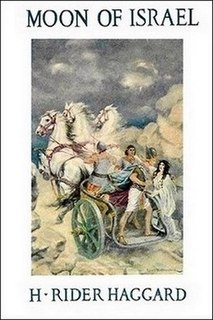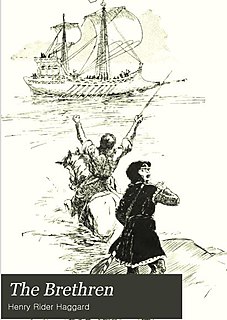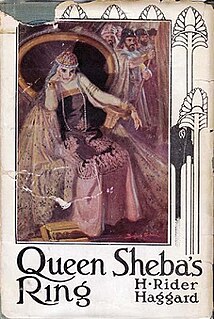
King Solomon's Mines (1885) is a popular novel by the English Victorian adventure writer and fabulist Sir H. Rider Haggard. It tells of a search of an unexplored region of Africa by a group of adventurers led by Allan Quatermain for the missing brother of one of the party. It is one of the first English adventure novels set in Africa and is considered to be the genesis of the lost world literary genre.

She, subtitled A History of Adventure, is a novel by the English writer H. Rider Haggard, published in book form in 1887 following serialisation in The Graphic magazine between October 1886 and January 1887. She was extraordinarily popular upon its release and has never been out of print.

Montezuma's Daughter, first published in 1892, is a novel by the Victorian adventure writer H. Rider Haggard. Narrated in the first person by Thomas Wingfield, an Englishman whose adventures include having his mother murdered by his Spanish cousin Juan de Garcia, a brush with the Spanish Inquisition, shipwreck, and slavery. Eventually, Thomas unwillingly joins a Spanish expedition to New Spain, and the novel tells a fictionalized story of the first interactions between the natives and European explorers. This includes a number of misunderstandings, prejudice on the part of the Spaniards, and ultimately open war.

Nada the Lily is an historical novel by English writer H. Rider Haggard, published in 1892. It is said to be inspired by Haggard's time in South Africa (1875–82). It was illustrated by Charles H. M. Kerr.

Moon of Israel is a novel by English writer H. Rider Haggard, first published in 1918 by John Murray. The novel narrates the events of the Biblical Exodus from Egypt told from the perspective of a scribe named Ana.
The Witch's Head is the second novel by H. Rider Haggard, which he wrote just prior to King Solomon's Mines.
Jess is a novel by British writer H. Rider Haggard, set in South Africa.

Mr Meeson's Will is an 1888 novel by H. Rider Haggard. It was based on a well known anecdote of the time. The plot concerns a marooned man's will tattooed on the back of a woman.

The Brethren is a 1904 historical novel by H. Rider Haggard set during the Third Crusade. The Brethren features Saladin and the Assassins as characters.

Fair Margaret is a 1907 novel by British writer H. Rider Haggard, set in the time of Henry VII of England. The plot features the abduction of the titular heroine and her adventures in Spain, including a meeting with King Ferdinand and Queen Isabella of Spain.

The Ghost Kings is a 1908 mystery-adventure novel by H Rider Haggard, set on the borders of Zululand in Africa.

The Yellow God: An Idol of Africa is a 1908 novel by H Rider Haggard.

The Lady of Blossholme is a 1909 historical novel by H. Rider Haggard. It is set during the time of Henry VIII, and features the Pilgrimage of Grace.

Queen Sheba's Ring is a 1910 adventure novel by H. Rider Haggard set in central Africa. It resembles the author's earlier works King Solomon's Mines and She, featuring plotting priests, beautiful women, and daring British adventurers.

The Ancient Allan is a novel by H. Rider Haggard.

Red Eve is a historical novel with fantasy elements, by British writer H. Rider Haggard, set in the reign of Edward III. Red Eve depicts the Battle of Crécy and the Black Death, and also features a supernatural personification of Death called Murgh.

Queen of the Dawn is a 1925 novel by British author H Rider Haggard, set in Ancient Egypt.

Mary of Marion Isle is a 1929 novel by H Rider Haggard. It was his penultimate novel and was published posthumously. Haggard originally came up with the idea for the novel in 1916 while on travelling on a ship from South Africa to Australia and glancing at the islands they passed on the way there.
Allan Quatermain is an 1887 novel by H. Rider Haggard. It is the sequel to Haggard's 1885 novel King Solomon's Mines.

Venetian Blind is a 1959 suspense novel by the British author William Haggard published in England by Cassell and in the United States by Ives Washburn. It was Haggard's second of 21 books involving his urbane protagonist Colonel Charles Russell, the head of the unobtrusive but lethal Security Executive, a government counter-intelligence agency clearly based on the actual MI5 or Security Service, where he moves easily and gracefully along C.P. Snow's Corridors of Power in Whitehall. Like all of Haggard's books it has standard elements of suspense thrillers but in addition there is an almost Henry Jamiesian exposition of British establishment mores and character, in both the government and in the world of upper-class financiers, scientists, industrialists, their families, and hangers-on, making it very much a novel of character.

















